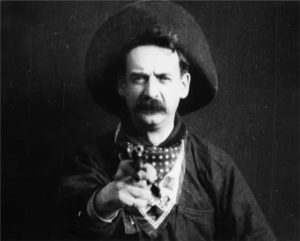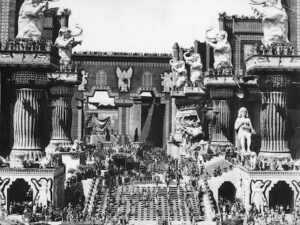Edwin Porter and David Griffith – The Beginning of American Cinema

The Great Train Robbery
Edwin Porter and David W. Griffith are two of the most important names of the early days of American film. Thanks to their innovative solutions and authorial vision, both have gone down in the history of cinema.
Edwin Porter – creator of film drama and cinematic excitement
Edwin Porter was Thomas Edison’s cinematographer, and he is considered the creator of so-called dramatic montage. In “Life of an American Fireman” (1902), depicting the rescue of a mother and child from a burning house, Porter used montage as an element to build mood and evoke emotion in the viewer. This method particularly came to a head in the famous “The Great Train Robbery” (1903). Here the plot took place in several action locations, and a close-up of a revolver pointed directly at the viewer made history.
It was Edwin Porter who was the first in the history of cinema to conclude that viewers need to experience authentic emotions during a screening, and not just watch moving images. To him, therefore, we owe the idea of plots rich in sensational twists and turns. The aforementioned “The Great Train Robbery”, in which the director showed the robbery of a train by a gang of criminals, is precisely in this style. Porter also filmed the pursuit of the bandits and their killing. Thus, this film is considered not only the beginning of thriller and western cinema, but also the inauguration of feature cinema.
Later, Edwin Porter shot longer works, such as “The Count of Monte Christo” (1912) and “The Prisoner of Zenda” (1913), as well as films with Mary Pickford – “In the Bishop’s Carriage” (1913) and “Tess from the Land of Storms” (1914). Porter’s experiments with three-dimensional imagery are also worth mentioning. Indeed, he used this method to show Niagara Falls.
David Griffith – creator of film fiction and film acting

American film has built its language on the works of David Wark Griffith, considered the first conscious artist of cinema. In the works of this director, the plot resembles the flowing narrative of a 19th-century novel: it is multilayered, abounds in flashbacks, and tension is built mainly through the use of synchronous editing (different events take place at the same time).
Two of Griffith’s films are particularly noted in cinema history: “The Birth of a Nation” (1915) about the Civil War and “Intolerance” (1916). The ending of Intolerance can be cited as a flagship example of masterful synchronic editing, when the Cameron family, trapped in a small cabin, is attacked by Negroes while the Ku-Klux-Klan rushes to their aid (note: the film is incredibly racist !).
But whatever one may think of David Griffith, his achievements in the field of constructing cinematic fiction are epoch-making. It was he who taught cinema how to tell the world through images, discovered the importance of psychological construction of characters and exploited the potential of realism. One can even see references to realist painting in his movies. What’s more, Griffith was the first to be able to smoothly apply the variation of sets – close-ups and overall sets. He paid a lot of attention to the way the frame was composed, and therefore recognized the role of scenery, costumes and props.
David Griffith’s huge achievement in the context of the history of cinema was also the abandonment of theatrical acting, with exaggerated gesticulation and body language, in favor of typical film acting, imitating everyday human behavior as much as possible. This was one of the reasons for the great popularity of this director’s films in the first and second decades of the 20th century. Griffith won the hearts of the public primarily as the author of melodramas with Lillian Gish, such as “Broken Blossom”, 1919. In them, the director was able to use all the means of cinema to create images that were moving and authentic.
